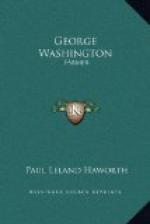Artists came to paint the great man’s picture; the sculptor Houdon to take the great man’s bust, arriving from Alexandria, by the way, after the family had gone to bed; the Marquis de Lafayette to visit his old friend; Mrs. Macaulay Graham to obtain material for her history; Noah Webster to consider whether he would become the tutor of young Custis; Mr. John Fitch, November 4, 1785, “to propose a draft & Model of a machine for promoting Navigation by means of a Steam”; Charles Thomson, secretary of the Continental Congress, to notify the General of his election to the presidency; a host of others, some out of friendship, others from mere curiosity or a desire for free lodging.
The visit of Lafayette was the last he made to this country while the man with whose fame his name is inseparably linked remained alive. He visited Mount Vernon in August, 1784, and again three months later. When the time for a final adieu came Washington accompanied him to Annapolis and saw him on the road to Baltimore. The generous young benefactor of America was very dear to Washington, and the parting affected him exceedingly. Soon after he wrote to the departed friend a letter in which he showed his heart in a way that was rare with him. “In the moment of our separation,” said he, “upon the road as I travelled, and every hour since, I have felt all the love, respect, and attachment for you with which length of years, close connextion, and your merits have inspired me. I have often asked myself, as our carriages separated, whether that was the last sight I ever should have of you.”
It was a true foreboding. Often in times that followed Washington was to receive tidings of his friend’s triumphs and perilous adventures amid the bloody turmoil of the French Revolution, was to entertain his son at Mount Vernon when the father lay in the dark dungeons of Olmuetz, but was never again to look into his face. Years later the younger man, revisiting the grateful Republic he had helped to found, was to turn aside from the acclaiming plaudits of admiring multitudes and stand pensively beside the Tomb of his Leader and reflect upon the years in which they had stood gloriously shoulder to shoulder in defense of a noble cause.
Even when Washington was at the seat of government many persons stopped at Mount Vernon and were entertained by the manager. Several times the absent owner sent wine and other luxuries for the use of such guests. When he was at home friends, relatives, diplomats, delegations of Indians to visit the Great White Father swarmed thither in shoals. In 1797 young Lafayette and his tutor, Monsieur Frestel, whom Washington thought a very sensible man, made the place, by invitation, their home for several months. In the summer of that year Washington wrote to his old secretary, Tobias Lear: “I am alone at present, and shall be glad to see you this evening. Unless some one pops in unexpectedly—Mrs. Washington and myself will do what I believe has not been done within the last twenty Years by us,—that is to set down to dinner by ourselves.”




